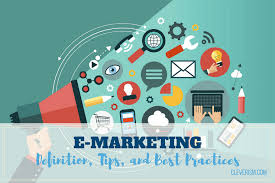
Unlocking the Power of E-Marketing: Strategies for Success in the Digital Age
The Power of E-Marketing in Today’s Digital World
In the fast-paced digital landscape of today, e-marketing has emerged as a powerful tool for businesses to reach and engage with their target audiences. E-marketing, also known as electronic marketing or online marketing, encompasses a wide range of strategies and tactics that leverage the internet and digital technologies to promote products or services.
Benefits of E-Marketing:
Global Reach: One of the key advantages of e-marketing is its ability to reach a global audience. Through various online channels such as websites, social media, email campaigns, and search engine optimisation (SEO), businesses can connect with potential customers across geographical boundaries.
Cost-Effective: Compared to traditional marketing methods, e-marketing is often more cost-effective. Businesses can reach a large audience at a fraction of the cost through targeted online advertising and promotional campaigns.
Measurable Results: E-marketing allows businesses to track and measure the performance of their campaigns in real-time. Metrics such as website traffic, conversion rates, email open rates, and social media engagement provide valuable insights that can be used to refine marketing strategies for better results.
Key Strategies in E-Marketing:
Social Media Marketing: Leveraging popular social media platforms like Facebook, Instagram, Twitter, and LinkedIn to engage with audiences, build brand awareness, and drive traffic to websites.
Email Marketing: Sending targeted emails to segmented lists of subscribers to promote products or services, share company updates, and nurture customer relationships.
Content Marketing: Creating valuable and relevant content such as blog posts, videos, infographics, and whitepapers to attract and engage target audiences while establishing authority in the industry.
The Future of E-Marketing:
E-marketing continues to evolve rapidly with advancements in technology and changing consumer behaviours. As businesses adapt to new trends such as artificial intelligence (AI), voice search optimisation, and personalisation techniques, the future of e-marketing holds immense potential for innovative strategies that deliver personalised experiences for consumers.
Exploring E-Marketing: Common Questions and Key Concepts
- Is e-marketing the same as digital marketing?
- What is the e market?
- What is the types of E-Marketing?
- What is the introduction of e-marketing?
- What is meant by E-Marketing?
- How many types of e marketing are there?
- What are the 4 types of digital marketing?
- What is E-Marketing and its strategies?
- What are the 4 E’s of marketing?
Is e-marketing the same as digital marketing?
In the realm of online marketing, a common query often arises: Is e-marketing the same as digital marketing? While the terms are sometimes used interchangeably, there are subtle distinctions between the two concepts. E-marketing primarily focuses on promotional activities conducted through electronic means, including email marketing, online advertising, and social media campaigns. On the other hand, digital marketing encompasses a broader scope, incorporating all forms of online and offline marketing efforts that leverage digital channels to reach and engage with target audiences. Therefore, while e-marketing is a subset of digital marketing, the latter encompasses a wider array of strategies and tactics in today’s interconnected digital landscape.
What is the e market?
The e-market, short for electronic market, refers to the online marketplace where buying and selling of goods and services take place over the internet. It encompasses a digital ecosystem where businesses and consumers interact virtually to conduct transactions. The e-market provides a platform for companies to showcase their products, reach a wider audience, and engage with customers through various online channels such as websites, social media platforms, and online marketplaces. This digital marketplace offers convenience, accessibility, and global reach, transforming the way businesses operate and connect with their target market in today’s digital age.
What is the types of E-Marketing?
When it comes to e-marketing, there are various types of strategies and tactics that businesses can utilise to promote their products or services online. Some common types of e-marketing include social media marketing, email marketing, content marketing, search engine optimisation (SEO), pay-per-click advertising (PPC), affiliate marketing, and influencer marketing. Each type of e-marketing has its own unique benefits and can be tailored to suit different business goals and target audiences. By leveraging a combination of these e-marketing types, businesses can create comprehensive and effective online marketing campaigns to reach and engage with their customers in the digital realm.
What is the introduction of e-marketing?
The introduction of e-marketing, also known as electronic marketing or online marketing, marks a significant shift in the way businesses promote their products and services in the digital age. E-marketing leverages the power of the internet and digital technologies to reach and engage with target audiences on a global scale. By utilising various online channels such as websites, social media platforms, email campaigns, and search engine optimisation (SEO), businesses can enhance their visibility, drive traffic, and ultimately increase conversions. E-marketing offers a cost-effective and measurable approach to marketing that allows businesses to adapt to changing consumer behaviours and stay competitive in today’s dynamic marketplace.
What is meant by E-Marketing?
E-Marketing, short for electronic marketing, refers to the use of digital technologies and online platforms to promote products or services to a target audience. It encompasses a wide range of strategies such as social media marketing, email campaigns, search engine optimisation (SEO), and content marketing to reach customers and drive engagement. E-Marketing leverages the power of the internet to connect businesses with their audiences in a cost-effective and measurable way, allowing for targeted communication and tailored campaigns that can yield significant results in today’s digital landscape.
How many types of e marketing are there?
When it comes to e-marketing, there are several types of strategies that businesses can utilise to promote their products or services online. Some common types of e-marketing include social media marketing, email marketing, content marketing, search engine optimisation (SEO), pay-per-click advertising (PPC), influencer marketing, and affiliate marketing. Each type of e-marketing serves a specific purpose and can be tailored to suit the goals and target audience of a business. By combining different e-marketing strategies effectively, businesses can create a comprehensive digital marketing plan to reach and engage with their online audience successfully.
What are the 4 types of digital marketing?
In the realm of e-marketing, there are four main types of digital marketing strategies that businesses commonly utilise to reach and engage with their target audiences. These include search engine optimisation (SEO), which focuses on improving a website’s visibility in search engine results; pay-per-click (PPC) advertising, where businesses pay for ads displayed on search engines; social media marketing, which involves promoting products or services on social platforms; and content marketing, which entails creating valuable and relevant content to attract and engage customers. Each type plays a crucial role in a comprehensive e-marketing strategy, offering unique opportunities to connect with consumers in the digital landscape.
What is E-Marketing and its strategies?
E-Marketing, short for electronic marketing, refers to the use of digital channels and technologies to promote products or services online. It encompasses a wide range of strategies aimed at reaching and engaging with target audiences in the digital space. Some key strategies in e-marketing include social media marketing, where businesses leverage platforms like Facebook, Instagram, and LinkedIn to connect with customers; email marketing, which involves sending targeted emails to subscribers for promotional purposes; and content marketing, which focuses on creating valuable and relevant content to attract and engage audiences. These strategies are essential components of e-marketing that help businesses establish an online presence, drive traffic to their websites, and ultimately boost sales and brand awareness in the digital realm.
What are the 4 E’s of marketing?
In the realm of e-marketing, the concept of the 4 E’s of marketing is often discussed as a framework for understanding and implementing effective digital strategies. The 4 E’s stand for Experience, Exchange, Everyplace, and Evangelism. Experience emphasises providing customers with a seamless and engaging online experience. Exchange focuses on creating value through transactions and interactions. Everyplace highlights the importance of being present across multiple digital touchpoints. Evangelism encourages building brand advocates who spread positive word-of-mouth online. By incorporating these 4 E’s into their e-marketing efforts, businesses can enhance customer relationships, drive engagement, and ultimately achieve success in the digital landscape.

